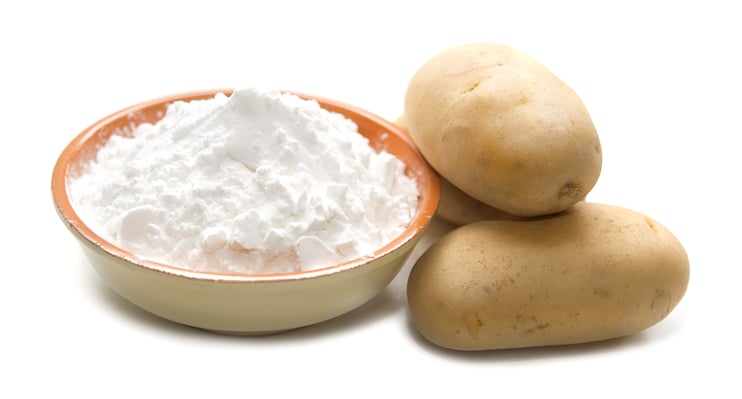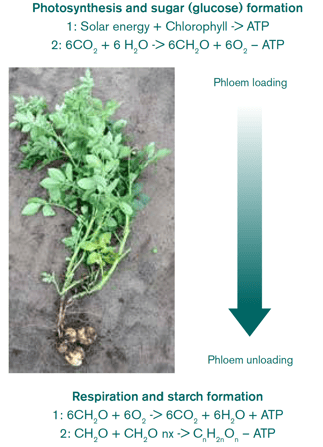
In the dark, no photosynthesis takes place. To the contrary, a reverse process occurs— respiration—whereby sugars are respired producing a molecule called ATP (adenosine triphosphate). ATP is formed from a phosphate ion (P) with adenosine diphosphate (ADP) thanks to solar energy or energy released by respiring sugars. ATP is the molecule that is used to deliver energy where it is needed in cells of the potato plant in order to make enzymes and their metabolites.
Both the rates of photosynthesis and respiration can be measured using an infrared gas analyzer (IRGA). This apparatus measures the concentration of incoming and outgoing CO2 in a small chamber that contains a leaf. A typical pattern of the rate of photosynthesis of a potato plant over a sunny dry day shows a midday dip. The photosynthetic rate is zero before sunrise, becomes maximal just before noon and then often shows a dip. This because plants partly close their stomates when the roots cannot maintain water uptake required for the transpiration demand of the leaves. When transpiration declines later during the day, stomata open again and photosynthesis increases until it diminishes due to declining solar radiation until it reaches zero again at sundown.
Starch formation
The main component of a potato tuber is starch (from stark = strong, Stärke in German) or amylum (from the Greek amulon: related to milling). Starch is the main source of energy for animals and also for humans. Starch is also the main component of cereals such as wheat, corn and rice. A few plant species such as chicory and Jerusalem artichoke do not contain starch but inulin which are chains of up to 100 fructose molecules.
Glucose units
Starch is a polysaccharide that consists of hundreds to thousands of glucose units. It consists of 20% of the unbranched amylose chain and 80% of branched amylopectin chains. In the process of photosynthesis, water and carbon dioxide are reduced at the expense of solar energy to produce triose phosphates, which are the building blocks of starch. Sugars are formed in the leaves and sucrose (fructose + glucose) uploaded to the phloem and transported through the phloem to the growing tubers and other growing plant parts where phloem unloading takes place. The enzyme starch synthase glues the glucose phosphate molecules together using energy delivered by ATP. Initially, unbranched amylose is made, but with the aid of a branching enzyme, branched amylopectin is formed. Although in terms of weight there is four times more amylopectin than amylose, there are more than hundred times as many amylose molecules because they are much smaller than amylopectin.
Soluble and transportable sugars
Starch is not soluble in water. When the tubers start to sprout and form aboveground stems, starch is broken down through hydrolysis into soluble and transportable sugars by amylase. The enzyme amylase is also present in human saliva. Hydrolysis is the division of large molecules into smaller ones while they absorb water. Starch granules of potato starch are quite large (100 micro meter diameter, μm) compared to 2 μm of those of rice. These granules are formed through starch synthesis and are stored in amyloplasts, which are specific plastids in the cells of the potato tubers.

Photosynthesis, driven by solar energy, delivers the energy carrier ATP used for the formation of sugars in the leaves, which are loaded to the phloem and are transported to the tubers. In the tuber, upon unloading of the sugars, a part of the sugars is respired to deliver ATP that is needed to synthesize starch as this is an energy costing process.
Want to keep reading about the potato crop, photosynthesis and starch formation in potatoes?
Our Potato handbook is a global potato university in 1 book!
Buy your copy today and get a one-year free subscription to PotatoWorld magazine.

